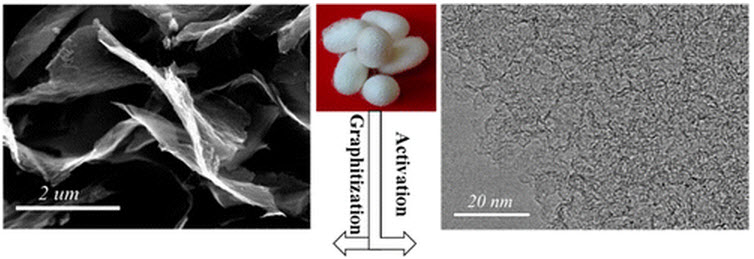Silk may be the new ‘green’ ultra-high-capacity material for batteries
March 11, 2015

Silk (top) is graphetized (left) to create porous nitrogen-doped carbon nanosheets (right) as an improved ultra-high-capacity material for battery anodes and supercapacitors (credit: Jianhau Hou et al./ACS Nano)
Scientists at Beijing Institute of Technology have developed a new “green” method to boost the performance of widely used lithium-ion (Li-ion) batteries, using a material derived from silk.
Currently, graphite (a form of carbon found in “lead” pencils) is used in Li-ion energy storage devices, including batteries and supercapacitors.
Chuanbao Cao and colleagues found a sustainable solution: a one-step process for using natural silk to create carbon-based nanosheets that could potentially be used in energy-storage devices, the researchers report in ACS Nano.
The porous nitrogen-doped material for battery anodes stores five times more lithium than graphite can — a capacity that is critical to improving battery performance. It also worked for more than 10,000 cycles with only a 9 percent loss in stability.
The researchers successfully incorporated their material in prototype batteries and supercapacitors in a one-step method that could easily be scaled up, the researchers note.
The authors acknowledge funding from the National Natural Science Foundation of China.
Abstract of Hierarchical Porous Nitrogen-Doped Carbon Nanosheets Derived from Silk for Ultrahigh-Capacity Battery Anodes and Supercapacitors
Hierarchical porous nitrogen-doped carbon (HPNC) nanosheets (NS) have been prepared viasimultaneous activation and graphitization of biomass-derived natural silk. The as-obtained HPNC-NS show favorable features for electrochemical energy storage such as high specific surface area (SBET: 2494 m2/g), high volume of hierarchical pores (2.28 cm3/g), nanosheet structures, rich N-doping (4.7%), and defects. With respect to the multiple synergistic effects of these features, a lithium-ion battery anode and a two-electrode-based supercapacitor have been prepared. A reversible lithium storage capacity of 1865 mA h/g has been reported, which is the highest for N-doped carbon anode materials to the best of our knowledge. The HPNC-NS supercapacitor’s electrode in ionic liquid electrolytes exhibit a capacitance of 242 F/g and energy density of 102 W h/kg (48 W h/L), with high cycling life stability (9% loss after 10 000 cycles). Thus, a high-performance Li-ion battery and supercapacitors were successfully assembled for the same electrode material, which was obtained through a one-step and facile large-scale synthesis route. It is promising for next-generation hybrid energy storage and renewable delivery devices.